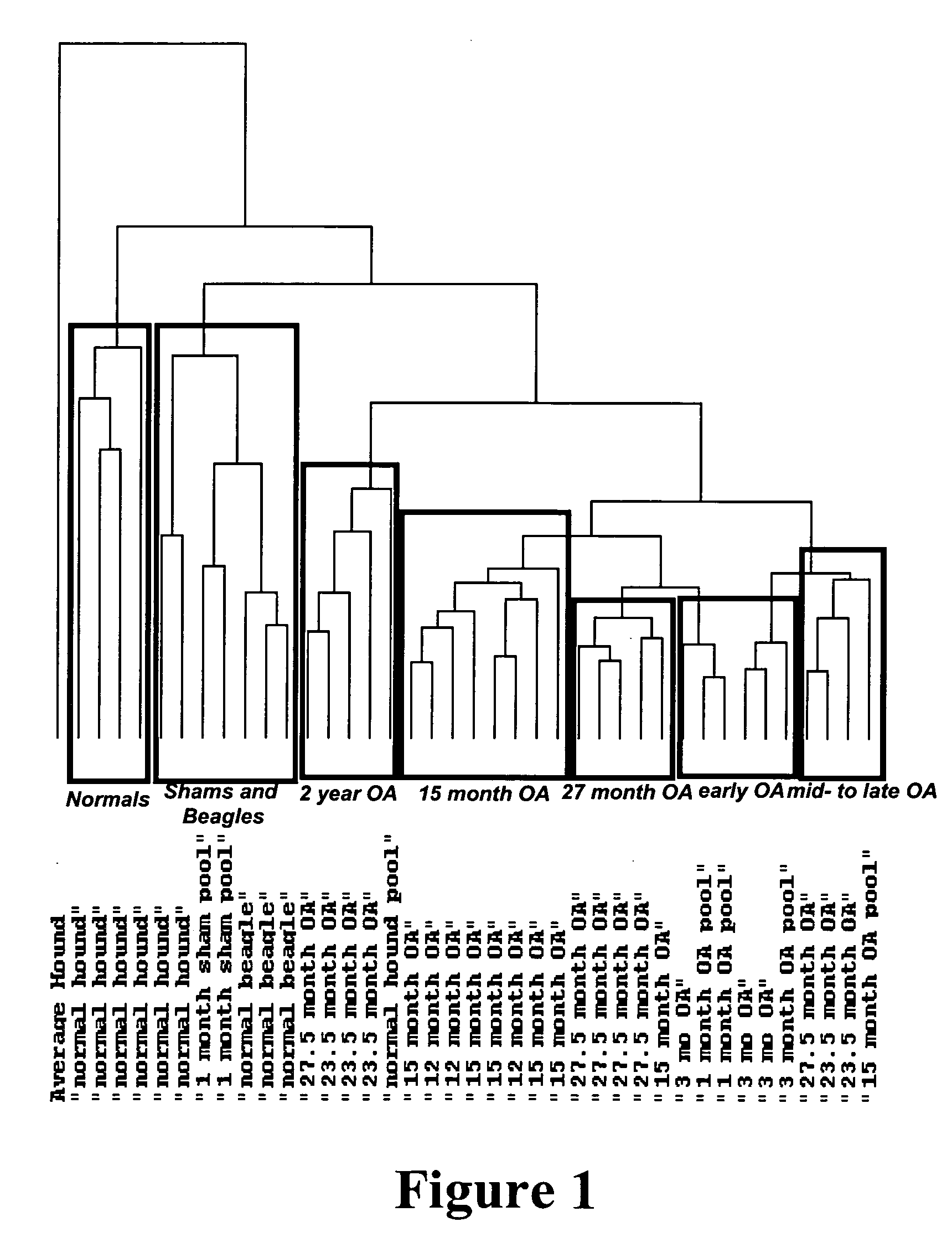Nucleic acid arrays for detecting gene expression in animal models of inflammatory diseases
a technology of inflammatory diseases and nucleic acid arrays, which is applied in the field of nucleic acid arrays, can solve the problems of joint pain, swelling and stiffness of joints, loss of cartilage, and damage to joint surfaces and adjacent bones
- Summary
- Abstract
- Description
- Claims
- Application Information
AI Technical Summary
Benefits of technology
Problems solved by technology
Method used
Image
Examples
example 1
Preparation of Canis familiars Cartilage cDNA Libraries
[0123] The cartilage tissue is harvested from non-osteoarthritic or osteoarthritis-affected dogs, and then placed in Dulbecco's Modified Eagle Medium (DMEM, Gibco / BRL) supplemented with antibiotics (penicillin, streptomycin, and gentamicin). The cartilage is removed aseptically from the underlying bone, rinsed in DMEM and diced into small pieces, and then placed in 100 mm petri dishes containing 20 ml of Neuman and Tytell's serum free medium (GIBCO / BRL). Using the protocol of G. Cathala et al., DNA 2:329-335 (1983), the cartilage from each dog is digested with 4 mg / ml pronase (Sigma, St Louis) for 1.5 hours, and then digested with 3 mg / ml bacterial collagenase (Sigma) for 1.5 hours. The digested material is filtered through a cell strainer, and the cells are pelleted by centrifugation. The cell pellet is washed once with phosphate buffered saline and then dissolved in 5 ml of buffer consisting of 5M guanidine isothiocyanate, 10...
example 2
Analysis of Cartilage cDNA Libraries
[0125] To assess the quality of the Canis familiars cartilage cDNA libraries, 379 3′ sequence reads were produced from an osteoarthritis-affected cartilage cDNA library, and 432 3′ sequence reads were generated from an non-osteoarthritic cartilage cDNA library. Each of the 3′ sequence reads was compared by BLASTN to both the human genome as well as the human sequences present in GenBank. Table H shows the BLASTN results for the 3′ sequence reads from the osteoarthritis-free library (“Free”) as well as from the osteoarthritis-affected library (“Affected”). Those 3′ sequence reads that were mapped to a human cDNA with an expect (“e-”) value no less than 10−14 were considered to be homologous to the human transcript.
TABLE HAnalysis of Cartilage cDNA LibrariesA-FGene SymbolGene NameFreeAffectedChangeGPmatrix Gla protein70−7RPL10ribosomal protein L1082−6RPS3Aribosomal protein S3A61−5CHADchondroadherin41−3CLUclusterin (complement lysis inhibitor, SP-...
example 3
Nucleic Acid Array
[0129] The tiling sequences depicted in Table C were submitted to Affymetrix for custom array design. Affymetrix selected probes for each tiling sequence using its probe-picking algorithm. Non-ambiguous probes with 25 bases in length were selected. Sixteen probe-pairs were requested for each tiling sequence with a minimum number of acceptable probe-pairs set to twelve. The final array was directed to 11,986 Canis familiars transcripts and contained 197,796 perfect match probes and 197,796 mismatch probes, including 137 exogenous control probe sets. These probes are shown in Table I.
[0130] The probes in Table I are perfect match probes and correspond to SEQ ID NOs: 12,312-210,107, respectively. Each probe in Table I has a qualifier which is identical to the qualifier of the corresponding tiling sequence from which the probe is derived. The strandedness of each probe (“Direction”) is also demonstrated.
[0131]FIG. 1 represents an Eisen cluster of transcriptional pro...
PUM
| Property | Measurement | Unit |
|---|---|---|
| temperature | aaaaa | aaaaa |
| pH | aaaaa | aaaaa |
| Tm | aaaaa | aaaaa |
Abstract
Description
Claims
Application Information
 Login to View More
Login to View More - R&D
- Intellectual Property
- Life Sciences
- Materials
- Tech Scout
- Unparalleled Data Quality
- Higher Quality Content
- 60% Fewer Hallucinations
Browse by: Latest US Patents, China's latest patents, Technical Efficacy Thesaurus, Application Domain, Technology Topic, Popular Technical Reports.
© 2025 PatSnap. All rights reserved.Legal|Privacy policy|Modern Slavery Act Transparency Statement|Sitemap|About US| Contact US: help@patsnap.com

